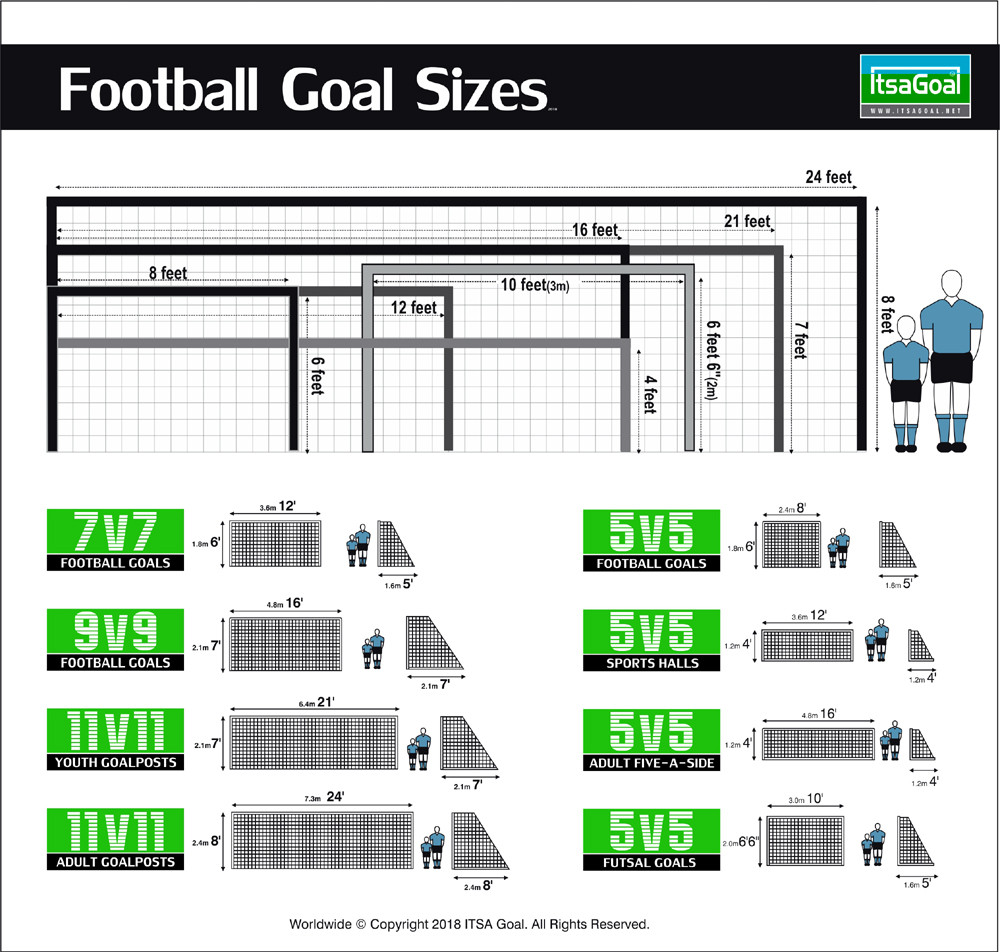Are you curious about the dimensions of a football goal? The length of a football goal varies depending on the age and level of play. At CAUHOI2025.UK.COM, we provide comprehensive information on football goal sizes, from youth leagues to professional matches. Discover the standard football goal dimensions and regulations with our detailed guide. Learn about different goal sizes, dimensions, and regulations, or even explore the goal’s impact on gameplay, youth development, and field design.
1. Understanding Football Goal Dimensions
The dimensions of a football goal are crucial for fair play and match integrity. The size varies depending on the level of play, ranging from youth leagues to professional matches. This section will delve into the specifics of these dimensions, exploring the regulations set by governing bodies and the impact of goal size on the game.
1.1. Standard Dimensions for Different Levels
The standard size for a full-size adult football goal, as regulated by FIFA, is 24 feet (8 yards or 7.32 meters) wide and 8 feet (2.44 meters) high. However, this is not the only size used in football. Different age groups and types of play use goals of varying sizes to suit the players’ abilities and the field dimensions.
- Youth Football Goals: These goals are smaller to accommodate younger players, typically ranging from 6 x 4 feet to 21 x 7 feet.
- 5-a-side Goals: Used in smaller sided games, these goals are even smaller, often around 12 x 4 feet.
- Futsal Goals: These goals measure 3 meters (approximately 9.8 feet) wide and 2 meters (approximately 6.6 feet) high.
1.2. Key Components of a Football Goal
A standard football goal comprises several key components that ensure its structural integrity and adherence to regulations.
- Crossbar: This is the horizontal beam connecting the two goalposts. According to FIFA, the crossbar must be the same material as the goalposts, typically wood, metal, or other approved material.
- Goalposts: The two vertical posts that support the crossbar. They must be white and of the same width, which should not exceed 5 inches (12 cm).
- Net: While not technically part of the goal’s structure, the net is an essential component. It is attached to the goalposts and crossbar and must be fixed in a way that does not obstruct the goalkeeper.
2. Regulations Governing Football Goal Sizes
Various governing bodies, including FIFA and national football associations, set regulations for football goal sizes to ensure fair play across different levels of competition. These regulations specify the precise dimensions and materials allowed for goalposts, crossbars, and nets.
2.1. FIFA Regulations
FIFA’s Laws of the Game outline the official regulations for football goal sizes used in professional and international matches. According to FIFA, the inner distance between the posts is 7.32 meters (8 yards), and the distance from the lower edge of the crossbar to the ground is 2.44 meters (8 feet).
2.2. Youth Football Associations
Youth football associations often have their own guidelines for goal sizes, which are tailored to the age and skill level of young players. For example, U.S. Youth Soccer recommends smaller goal sizes for younger age groups to promote more scoring opportunities and player development.
2.3. The FA Guidelines
The Football Association (The FA) provides specific guidelines for goalpost sizes based on age groups. For instance, 9v9 games typically use a goal size of 16 x 7 ft, while 5v5 games use goals that are 12 x 6 ft. These dimensions are carefully considered to ensure that the goals are proportionate to the size of the pitch and the players.
3. Football Goal Dimensions for Different Age Groups and Formats
Football goal dimensions are meticulously adjusted to cater to various age groups and formats, ensuring fair play and promoting player development. Let’s delve into the specifics of goal sizes for different levels of play:
3.1. Youth Football Goal Sizes
Youth football prioritizes skill development and enjoyment, and the goal sizes reflect this. Here’s a breakdown of typical goal dimensions for young players:
- U6-U8 (4v4/5v5): Goals typically measure 6 x 4 feet to 12 x 6 feet. These smaller goals encourage more scoring opportunities and keep young players engaged.
- U9-U10 (7v7): A common size is 18 x 6 feet. This size allows for a greater challenge as players develop their shooting accuracy.
- U11-U12 (9v9): Goals are often 21 x 7 feet. This increase in size prepares players for the transition to full-size goals.
3.2. Adult Football Goal Sizes
As players mature, the goal size increases to provide a greater challenge and more realistic game conditions:
- 11v11 (Standard): The official FIFA regulation size is 24 x 8 feet. This is the standard size for professional and amateur adult matches.
- Futsal: Futsal goals are smaller, measuring approximately 9.8 x 6.6 feet. The smaller goal size complements the fast-paced, technical nature of the game.
3.3. Variations in Goal Size
Certain formats and leagues may have slightly different goal size regulations:
- Indoor Soccer: Goal sizes can vary depending on the specific indoor facility. However, they are generally smaller than standard 11v11 goals.
- Recreational Leagues: Some recreational leagues might use slightly smaller goals to accommodate smaller field sizes or player preferences.
4. The Impact of Goal Size on Gameplay
The size of the football goal significantly influences gameplay, affecting scoring rates, tactical approaches, and player development. Different goal sizes create unique challenges and opportunities, shaping how the game is played at various levels.
4.1. Scoring Rates and Game Dynamics
Smaller goals, often used in youth leagues, generally lead to higher scoring rates. This can make games more exciting and engaging for young players, encouraging them to develop their attacking skills. Conversely, larger goals, such as those used in professional matches, require more precision and power to score, leading to different tactical approaches.
4.2. Tactical Implications
Goal size influences tactical decisions made by coaches and players. For example, when playing with smaller goals, teams may focus on close-range shooting and quick passing combinations to create scoring opportunities. With larger goals, there may be a greater emphasis on long-range shots and set-piece strategies.
4.3. Impact on Goalkeeping
The size of the goal also significantly impacts goalkeeping. Goalkeepers facing smaller goals may need to focus on agility and quick reflexes, while those defending larger goals require excellent positioning and shot-stopping abilities. The United States Soccer Federation offers resources and training programs that emphasize these specific skills.
5. Choosing the Right Goal Size
Selecting the appropriate goal size is crucial for creating a fair and developmental environment for players of all ages and skill levels. Factors such as field size, player abilities, and league regulations should be considered when making this decision.
5.1. Factors to Consider
When choosing a football goal size, consider the following factors:
- Age Group: Select goal sizes that align with the recommended dimensions for specific age groups to ensure fair play and promote skill development.
- Field Size: Ensure that the goal size is proportionate to the size of the field to maintain a balanced and engaging game.
- League Regulations: Adhere to the regulations set by the governing football associations or leagues to avoid any violations or penalties.
5.2. Practical Tips for Selection
Here are some practical tips for selecting the right goal size:
- Consult Guidelines: Refer to guidelines provided by FIFA, national football associations, and youth soccer organizations for recommended goal sizes based on age and level of play.
- Assess Player Abilities: Consider the skill levels and physical capabilities of the players to choose a goal size that provides an appropriate challenge.
- Seek Expert Advice: Consult with experienced coaches, referees, or sports equipment specialists for advice on selecting the most suitable goal size for your specific needs.
6. Innovations in Football Goal Technology
Football goal technology has seen significant advancements in recent years, with innovations aimed at enhancing safety, durability, and performance. These advancements include improvements in materials, design, and construction methods.
6.1. Material Enhancements
Modern football goals are often made from lightweight yet durable materials such as aluminum or reinforced PVC. These materials offer several advantages over traditional wood or steel goals, including increased portability, resistance to rust and corrosion, and enhanced safety.
6.2. Design Innovations
Design innovations in football goal technology have focused on improving stability, ease of assembly, and overall aesthetics. Some goals feature interlocking frames, adjustable height settings, and integrated net systems.
6.3. Safety Features
Safety is a top priority in football goal technology. Many modern goals are equipped with features such as padded goalposts, rounded edges, and anchoring systems to prevent tipping or collapse.
7. Maintenance and Safety of Football Goals
Proper maintenance and safety measures are essential for ensuring the longevity and safe use of football goals. Regular inspections, repairs, and adherence to safety guidelines can help prevent accidents and injuries.
7.1. Regular Inspections
Conduct regular inspections of football goals to identify any signs of damage, wear, or instability. Check for loose connections, cracks, rust, or any other issues that could compromise the goal’s structural integrity.
7.2. Maintenance Tips
Follow these maintenance tips to keep your football goals in good condition:
- Clean Regularly: Clean the goalposts and crossbar with a mild detergent and water to remove dirt, grime, and stains.
- Lubricate Moving Parts: Lubricate any moving parts, such as hinges or joints, to ensure smooth operation and prevent corrosion.
- Repair Damages Promptly: Repair any damages or defects promptly to prevent them from worsening and compromising the goal’s safety.
7.3. Safety Guidelines
Adhere to these safety guidelines to prevent accidents and injuries:
- Anchor Goals Securely: Always anchor football goals securely to the ground using appropriate anchoring systems to prevent tipping or collapse.
- Supervise Use: Supervise the use of football goals, especially by young children, to ensure they are used safely and responsibly.
- Store Goals Properly: Store football goals in a safe and secure location when not in use to prevent theft or damage.
 Football goal size comparison chart
Football goal size comparison chart
8. Football Field Dimensions and Goal Placement
The size of the football field and the placement of the goals are integral to the overall design and layout of the playing area. These dimensions and placements must adhere to regulations set by governing bodies to ensure fair play and consistency across different venues.
8.1. Standard Field Dimensions
According to FIFA, the standard field dimensions for international matches should be 105 meters (115 yards) long and 68 meters (74 yards) wide. However, these dimensions may vary for other levels of play, such as youth leagues or recreational games.
8.2. Goal Placement
The goals should be placed at the center of each goal line, equidistant from the corner flags. The goal lines are the shorter boundaries of the field, running parallel to each other at opposite ends of the playing area.
8.3. Impact on Field Design
The dimensions of the football field and the placement of the goals influence various aspects of field design, including the size of the penalty area, the location of the halfway line, and the positioning of the corner arcs.
9. The History of Football Goal Size
The evolution of football goal size reflects the changing dynamics of the sport. From its early, unregulated days to the standardization we see today, the goal’s dimensions have been refined to balance scoring opportunities and defensive challenges.
9.1. Early Football Goals
In the early days of football, there were no standardized rules for goal sizes. Goals were often improvised using whatever materials were available, such as trees, stones, or even players’ coats.
9.2. Standardization Efforts
As football became more organized, efforts were made to standardize the rules, including goal sizes. The Football Association (FA) played a key role in this process, establishing the first official dimensions for football goals.
9.3. Evolution Over Time
Over time, the dimensions of football goals have been refined and adjusted to improve the game’s balance and fairness. These changes have been influenced by factors such as player skill levels, tactical approaches, and the overall evolution of the sport.
10. Frequently Asked Questions (FAQs)
Q1: What is the official size of a standard adult football goal?
The official size of a standard adult football goal is 24 feet (8 yards or 7.32 meters) wide and 8 feet (2.44 meters) high, as regulated by FIFA.
Q2: What are the dimensions of a youth football goal?
Youth football goals vary in size depending on the age group, ranging from 6 x 4 feet to 21 x 7 feet.
Q3: What is the size of a futsal goal?
Futsal goals measure 3 meters (approximately 9.8 feet) wide and 2 meters (approximately 6.6 feet) high.
Q4: What materials are football goals typically made of?
Football goals are typically made of wood, metal, or other approved materials, such as aluminum or reinforced PVC.
Q5: How often should football goals be inspected for safety?
Football goals should be inspected regularly to identify any signs of damage, wear, or instability.
Q6: What safety features should football goals have?
Football goals should have safety features such as padded goalposts, rounded edges, and anchoring systems to prevent tipping or collapse.
Q7: How should football goals be stored when not in use?
Football goals should be stored in a safe and secure location when not in use to prevent theft or damage.
Q8: What factors should be considered when choosing a football goal size?
Factors to consider when choosing a football goal size include the age group, field size, and league regulations.
Q9: Where can I find more information about football goal regulations?
You can find more information about football goal regulations on the websites of FIFA, national football associations, and youth soccer organizations.
Q10: Why is goal size important in football?
Goal size is important for maintaining fair play, promoting player development, and ensuring consistency across different levels of competition.
11. Find the Answers You Need at CAUHOI2025.UK.COM
Finding reliable and accurate information about football goal sizes can be challenging. At CAUHOI2025.UK.COM, we provide thoroughly researched answers and expert advice to address all your questions. Whether you are a coach, player, or parent, our platform offers the clarity and support you need to make informed decisions.
11.1. Expert Answers and Trusted Advice
CAUHOI2025.UK.COM is committed to providing you with expert answers and trusted advice on a wide range of topics. Our team of knowledgeable professionals works diligently to ensure that our content is accurate, up-to-date, and easy to understand.
11.2. Comprehensive Information
Our website offers comprehensive information on various aspects of football, including goal sizes, field dimensions, regulations, and safety guidelines. Whether you are looking for general information or specific details, you can find it all at CAUHOI2025.UK.COM.
11.3. Contact Us
For more information, please visit our website at CAUHOI2025.UK.COM. Our headquarters is located at Equitable Life Building, 120 Broadway, New York, NY 10004, USA, and you can reach us by phone at +1 (800) 555-0199.
Ready to learn more and find the answers you need? Visit CauHoi2025.UK.COM today and explore our extensive collection of articles and resources. Don’t hesitate to contact us with your questions – we’re here to help!

